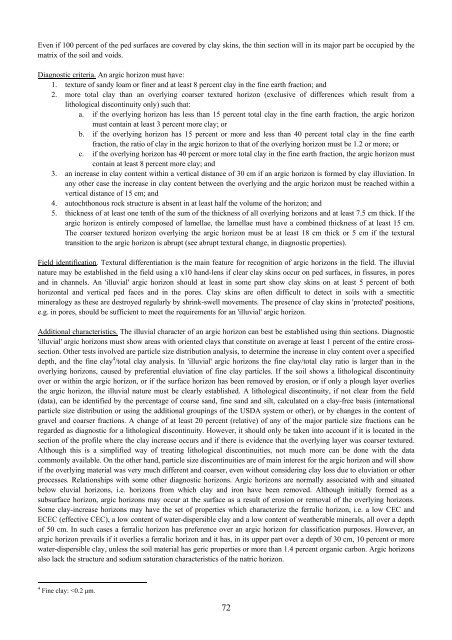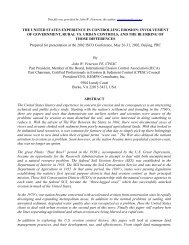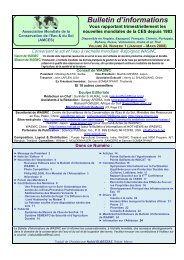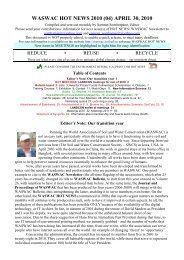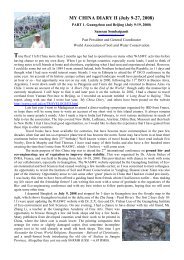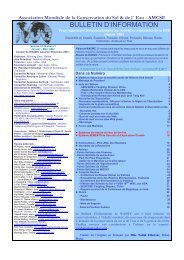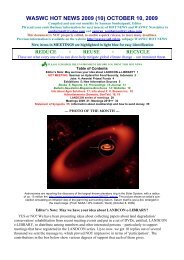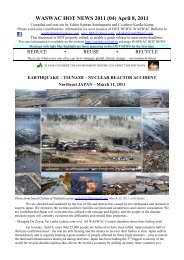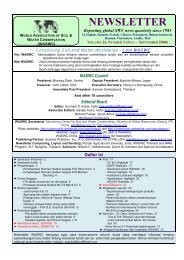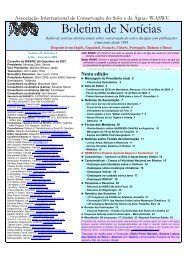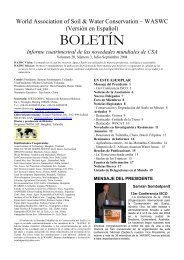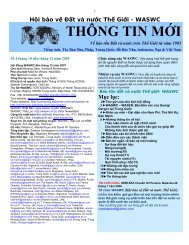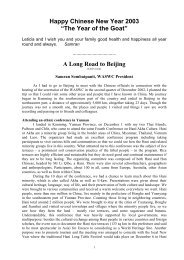Soils of the European Union - European Soil Portal - Europa
Soils of the European Union - European Soil Portal - Europa
Soils of the European Union - European Soil Portal - Europa
You also want an ePaper? Increase the reach of your titles
YUMPU automatically turns print PDFs into web optimized ePapers that Google loves.
Even if 100 percent <strong>of</strong> <strong>the</strong> ped surfaces are covered by clay skins, <strong>the</strong> thin section will in its major part be occupied by <strong>the</strong>matrix <strong>of</strong> <strong>the</strong> soil and voids.Diagnostic criteria. An argic horizon must have:1. texture <strong>of</strong> sandy loam or finer and at least 8 percent clay in <strong>the</strong> fine earth fraction; and2. more total clay than an overlying coarser textured horizon (exclusive <strong>of</strong> differences which result from alithological discontinuity only) such that:a. if <strong>the</strong> overlying horizon has less than 15 percent total clay in <strong>the</strong> fine earth fraction, <strong>the</strong> argic horizonmust contain at least 3 percent more clay; orb. if <strong>the</strong> overlying horizon has 15 percent or more and less than 40 percent total clay in <strong>the</strong> fine earthfraction, <strong>the</strong> ratio <strong>of</strong> clay in <strong>the</strong> argic horizon to that <strong>of</strong> <strong>the</strong> overlying horizon must be 1.2 or more; orc. if <strong>the</strong> overlying horizon has 40 percent or more total clay in <strong>the</strong> fine earth fraction, <strong>the</strong> argic horizon mustcontain at least 8 percent more clay; and3. an increase in clay content within a vertical distance <strong>of</strong> 30 cm if an argic horizon is formed by clay illuviation. Inany o<strong>the</strong>r case <strong>the</strong> increase in clay content between <strong>the</strong> overlying and <strong>the</strong> argic horizon must be reached within avertical distance <strong>of</strong> 15 cm; and4. autochthonous rock structure is absent in at least half <strong>the</strong> volume <strong>of</strong> <strong>the</strong> horizon; and5. thickness <strong>of</strong> at least one tenth <strong>of</strong> <strong>the</strong> sum <strong>of</strong> <strong>the</strong> thickness <strong>of</strong> all overlying horizons and at least 7.5 cm thick. If <strong>the</strong>argic horizon is entirely composed <strong>of</strong> lamellae, <strong>the</strong> lamellae must have a combined thickness <strong>of</strong> at least 15 cm.The coarser textured horizon overlying <strong>the</strong> argic horizon must be at least 18 cm thick or 5 cm if <strong>the</strong> texturaltransition to <strong>the</strong> argic horizon is abrupt (see abrupt textural change, in diagnostic properties).Field identification. Textural differentiation is <strong>the</strong> main feature for recognition <strong>of</strong> argic horizons in <strong>the</strong> field. The illuvialnature may be established in <strong>the</strong> field using a x10 hand-lens if clear clay skins occur on ped surfaces, in fissures, in poresand in channels. An 'illuvial' argic horizon should at least in some part show clay skins on at least 5 percent <strong>of</strong> bothhorizontal and vertical ped faces and in <strong>the</strong> pores. Clay skins are <strong>of</strong>ten difficult to detect in soils with a smectiticmineralogy as <strong>the</strong>se are destroyed regularly by shrink-swell movements. The presence <strong>of</strong> clay skins in 'protected' positions,e.g. in pores, should be sufficient to meet <strong>the</strong> requirements for an 'illuvial' argic horizon.Additional characteristics. The illuvial character <strong>of</strong> an argic horizon can best be established using thin sections. Diagnostic'illuvial' argic horizons must show areas with oriented clays that constitute on average at least 1 percent <strong>of</strong> <strong>the</strong> entire crosssection.O<strong>the</strong>r tests involved are particle size distribution analysis, to determine <strong>the</strong> increase in clay content over a specifieddepth, and <strong>the</strong> fine clay 4 /total clay analysis. In 'illuvial' argic horizons <strong>the</strong> fine clay/total clay ratio is larger than in <strong>the</strong>overlying horizons, caused by preferential eluviation <strong>of</strong> fine clay particles. If <strong>the</strong> soil shows a lithological discontinuityover or within <strong>the</strong> argic horizon, or if <strong>the</strong> surface horizon has been removed by erosion, or if only a plough layer overlies<strong>the</strong> argic horizon, <strong>the</strong> illuvial nature must be clearly established. A lithological discontinuity, if not clear from <strong>the</strong> field(data), can be identified by <strong>the</strong> percentage <strong>of</strong> coarse sand, fine sand and silt, calculated on a clay-free basis (internationalparticle size distribution or using <strong>the</strong> additional groupings <strong>of</strong> <strong>the</strong> USDA system or o<strong>the</strong>r), or by changes in <strong>the</strong> content <strong>of</strong>gravel and coarser fractions. A change <strong>of</strong> at least 20 percent (relative) <strong>of</strong> any <strong>of</strong> <strong>the</strong> major particle size fractions can beregarded as diagnostic for a lithological discontinuity. However, it should only be taken into account if it is located in <strong>the</strong>section <strong>of</strong> <strong>the</strong> pr<strong>of</strong>ile where <strong>the</strong> clay increase occurs and if <strong>the</strong>re is evidence that <strong>the</strong> overlying layer was coarser textured.Although this is a simplified way <strong>of</strong> treating lithological discontinuities, not much more can be done with <strong>the</strong> datacommonly available. On <strong>the</strong> o<strong>the</strong>r hand, particle size discontinuities are <strong>of</strong> main interest for <strong>the</strong> argic horizon and will showif <strong>the</strong> overlying material was very much different and coarser, even without considering clay loss due to eluviation or o<strong>the</strong>rprocesses. Relationships with some o<strong>the</strong>r diagnostic horizons. Argic horizons are normally associated with and situatedbelow eluvial horizons, i.e. horizons from which clay and iron have been removed. Although initially formed as asubsurface horizon, argic horizons may occur at <strong>the</strong> surface as a result <strong>of</strong> erosion or removal <strong>of</strong> <strong>the</strong> overlying horizons.Some clay-increase horizons may have <strong>the</strong> set <strong>of</strong> properties which characterize <strong>the</strong> ferralic horizon, i.e. a low CEC andECEC (effective CEC), a low content <strong>of</strong> water-dispersible clay and a low content <strong>of</strong> wea<strong>the</strong>rable minerals, all over a depth<strong>of</strong> 50 cm. In such cases a ferralic horizon has preference over an argic horizon for classification purposes. However, anargic horizon prevails if it overlies a ferralic horizon and it has, in its upper part over a depth <strong>of</strong> 30 cm, 10 percent or morewater-dispersible clay, unless <strong>the</strong> soil material has geric properties or more than 1.4 percent organic carbon. Argic horizonsalso lack <strong>the</strong> structure and sodium saturation characteristics <strong>of</strong> <strong>the</strong> natric horizon.4 Fine clay:


